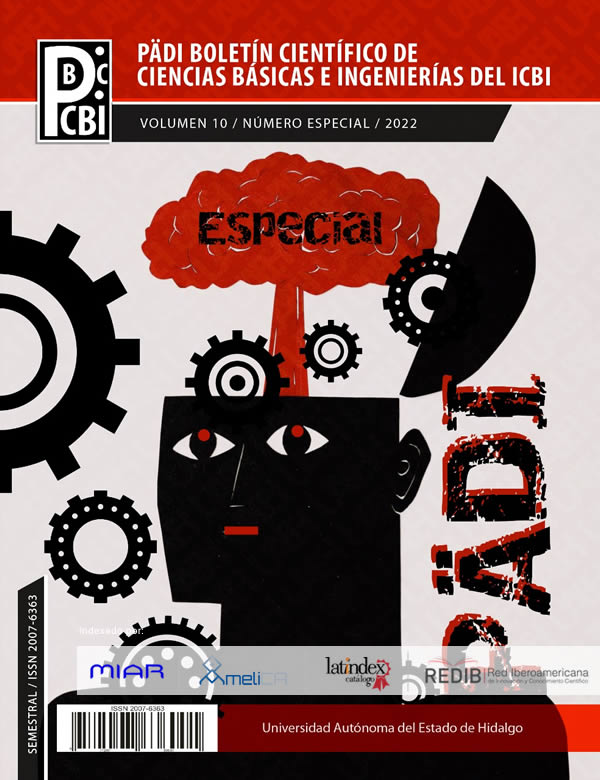Modelos epidemiológicos con control por vacunación en el estudio de la COVID-19
DOI:
https://doi.org/10.29057/icbi.v10iEspecial.8427Palabras clave:
Ecuaciones diferenciales, Modelaci´on matem´atica, Modelo SIR, Modelo SEIR, Din´amica COVID-19Resumen
En este artículo se analiza el desarrollo y la aplicación de las ecuaciones diferenciales en el análisis de epidemias mediante los modelos epidemiol´ogicos SIR y SEIR. En la primera parte del trabajo se analizan matemáticamente las ecuaciones definidas por ambos modelos. Posteriormente se simula numéricamente el desarrollo de una epidemia y se compara con el comportamiento matem´atico predicho. En la segunda parte del trabajo se estudia c´omo controlar la evoluci´on de una epidemia mediante m´etodos de vacunación. Primero se analizan los cambios que involucra la aplicaci´on de una vacuna en las ecuaciones. Posteriormente se simulan numéricamente estos modelos para analizar la evoluci´on de la población bajo diferentes esquemas de vacunaci´on. Finalmente se ponen en pr´actica los modelos para estudiar la evolución de la epidemia por COVID-19 en M´exico.
Descargas
Información de Publicación
Perfiles de revisores N/D
Declaraciones del autor
Indexado en
- Sociedad académica
- N/D
Citas
Andersson, H. and Britton, T. (2012). Stochastic epidemic models and their statistical analysis, volume 151. Springer Science & Business Media.
Bacaër,N.(2011). A Short History of Mathematical Population Dynamics. Springer Science & Business Media.
Bacaër, N., Ripoll, J., de la Parra, R. B., Bardina, X., and Cuadrado, S. (2021). Matemáticas y epidemias. Casini.
Brauer, F. (2017). Mathematical epidemiology: Past, present, and future. Infectious Disease Modelling, 2(2):113-127.
CDC (2021). Ending isolation and precautions for people with COVID-19: Interim guidance, centers for disease control and prevention.
Cherniha, R. and Davydovych, V. (2020). A mathematical model for the COVID-19 outbreak and its applications. Symmetry, 12(6):990.
Chu, J. (2021). A statistical analysis of the novel coronavirus (COVID-19) in italy and spain. PLoS ONE, 16(3):e0249037.
Earn, D., Rohani, P., Bolker, B., and Grenfell, B. (2000). A simple model for complex dynamical transitions in epidemics. Science, 287(5453):667–670.
Gumel, A., Iboi, E., Ngonghala, C., and Elbasha, E. (2021). A primer on using mathematics to understand COVID-19 dynamics: Modeling, analysis and simulations. Infectious Disease Modelling, 6:148–168.
Kermack, W. O. and McKendrick, A. G. (1927). A contribution to the mathematical theory of epidemics. Proceedings of the Royal Society of London. Series A, 115(772):700–721.
Li, M. and Muldowney, J. (1995). Global stability for the seir model in epidemiology. Mathematical Biosciences, 125:155–164.
Martcheva, M. (2015). An Introduction to Mathematical Epidemiology. Springer.
Martonosi, S., Behzad, B., and Cummings, K. (2021). Pricing the COVID-19 vaccine: A mathematical approach. Lancet Infect Dis, 21:793–802.
Moore, S., Hill, E., Tildesley, M., Dyson, L., and Keeling, M. (2021). Vaccination and non-pharmaceutical interventions for COVID-19: a mathematical modelling study. Omega, 103:102451.
Nåsell, I. (1999). On the time to extinction in recurrent epidemics. Journal of the Royal Statistical Society: Series B (Statistical Methodology), 61(2):309– 330.
Nesteruk, I. (2020). Statistics-based predictions of coronavirus epidemic spreading in mainland china. Innov Biosyst Bioeng, 4(1):13–18.
Olivares, A. and Staffetti, E. (2021). Uncertainty quantification of a mathematical model of COVID-19 transmission dynamics with mass vaccination strategy. Chaos, Solitons and Fractals, 146:110895.
Prodanov, D. (2021). Analytical parameter estimation of the sir epidemic mo- del. applications to the COVID-19 pandemic. Entropy, 25(59):e23010059.
Qi, H., Xiao, S., Shi, R., Ward, M. P., Chen, Y., Tu, W., Su, Q., Wang, W., Wang, X., and Zhang, Z. (2020). COVID-19 transmission in mainland china is as- sociated with temperature and humidity: a time-series analysis. Science of the total environment, 728:138778.
Tang, Y., Serdan, T., Masi, L., Tang, S., Gorjao, R., and Hirabara, S. (2020). Epidemiology of COVID-19 in brazil: Using a mathematical model to es- timate the outbreak peak and temporal evolution. Emerging Microbes & Infections, 9(1):1453–1456.
Van Herwaarden, O. A. and Grasman, J. (1995). Stochastic epidemics: major outbreaks and the duration of the endemic period. Journal of mathematical biology, 33(6):581–601.
Wang, J., Kaperak, C., Sato, T., and Sakuraba, A. (2021). COVID-19 reinfection: a rapid systematic review of case reports and case series. Journal of Investigative Medicine, 69(6):1253–1255.
WHO (2020). Novel coronavirus (2019-ncov): Situation report, 11. world health organization.
Zeroual, A., Harrou, F., Dairi, A., and Sun, Y. (2020). Deep learning methods for forecasting COVID-19 time-series data: A comparative study. Chaos, Solitons & Fractals, 140:110121.




















